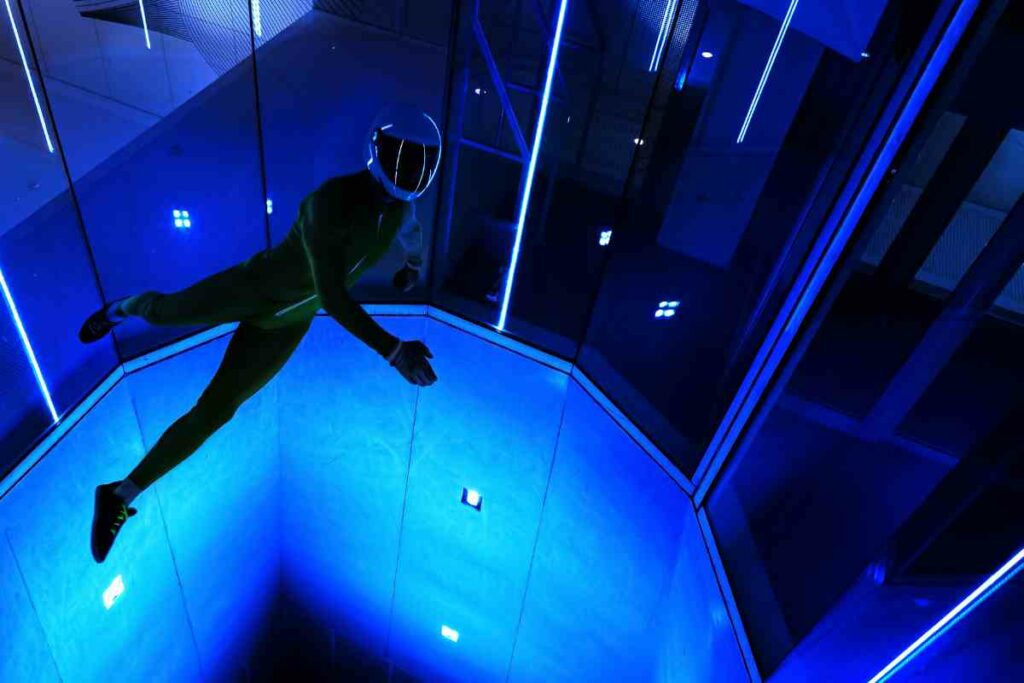When you’re flying inside a vertical wind tunnel, it’s crucial to stay in control of your body movements. Otherwise, you’ll be tossed around like a leaf in a hurricane!
To avoid this fate, all skydivers need to master the art of small adjustments and smooth transitions between positions.
It’s not easy, but with practice and skill-building exercises, anyone can get the hang of it.
Here is how.
How The Wind Tunnel Works
The wind tunnel is like a giant tube that blows air upwards at high speeds.

When you enter the tunnel (with your safety gear of course!), the airflow lifts you up and allows you to experience what it feels like to free-fall without actually jumping out of an airplane.
The wind tunnel for indoor skydiving consists of:
- Flight chamber
- Airflow system (creates upward wind)
- Fans (creates downflow wind)
- Turning vanes
- Diffuser
- Chillers or heaters
- Control system
Read before you go – Can You Indoor Skydive If You Have a Medical Condition?
Now, let me explain how this whole process works. As mentioned before, the wind tunnel uses powerful fans which push massive amounts of air through specially designed chambers in the floor and walls.
This creates a column of fast-moving air that rises through the middle or “flight chamber” section where people can fly.
When someone enters the flight chamber, they stretch their body out into a position known as ‘flying’ by positioning their hands along with their legs in particular ways so as to attain balance.
This helps them stay stable in preparation for flying just like one does while skydiving outdoors.
There are trained professionals around who look after your safety and help guide beginners to practice perfect stance posture etc
It may take some time to get used to flying inside such apparatus but once mastered, you feel complete control over movement.
How To Control Your Movements During Indoor Skydiving
Skysurfing is a fun and exciting experience that allows you to soar through the air in a safe indoor environment.
When skysurfing, it’s important to understand how to control your movements so that you can stay balanced and get the most out of your flight.
Here are some simple steps for controlling your movements during indoor skydiving.
1. Keep Your Body Straight
One of the keys to successful indoor skydiving is keeping your body straight and aligned with the wind tunnel. This will help keep you stable and prevent spinning or tumbling.
Wanna learn more? Dive in our Indoor Skydiving Beginners Guide and expand your knowledge today!
2. Watch Your Head Position
Your head position can also impact how well you maintain stability in the wind tunnel. It’s advisable always to keep looking up while flying.
3. Move Your Shoulders Slightly
If you find yourself starting to spin or lose balance, try moving your shoulders slightly in either direction instead of using large arm motions which might lead to further confusion.
4. Use Appropriate Arm Movements
You’ll use slight but deliberate arm movements according to Sky Surf instructor guidance throughout your session; getting feedback on what worked and what needs improvement is vital after each newly started class.
5. Kick Softly And Deliberately
The feet act as rudders when sky surfing – kicking softly will assist steer clear of any obstacles in the wind tunnel as well as maintain balance.
6. Relax Your Muscles
If you tense up or try to fight against the wind, it can make controlling your movements more difficult. Relax your muscles and let the airflow do most of the work.
7. Be Patient And Focus
Remember that indoor skydiving takes some practice; so always focus on what you’re doing and avoid being too hard on yourself when things don’t go according to plan. With patience and practice, you’ll soon learn how to control your movements with ease!
Safety Considerations
Just like any other adventure sport, indoor skydiving requires some level of caution and safety measures.
Before participating in indoor skydiving, you will receive proper instructions from the instructors on how to position your body while flying inside the wind tunnel.
It’s important to follow these directions as they ensure your safety during the experience.
You’ll also be provided with appropriate gear such as helmets, goggles, and suits; this gear is designed to keep you safe and comfortable throughout the whole process.
Additionally, make sure that you don’t have any medical conditions or injuries that might get aggravated by high-speed activities.
It’s always better to check with your doctor beforehand if everything is okay before attempting Indoor Skydiving.
Conclusion ?
In order to stay stable and in control during indoor skydiving, it is important to keep your body straight with a slight arch in the back.
Using small movements of the arms, legs, and core can help adjust your direction and speed. Focusing on breathing and staying calm will also aid in maintaining stability throughout the experience.







